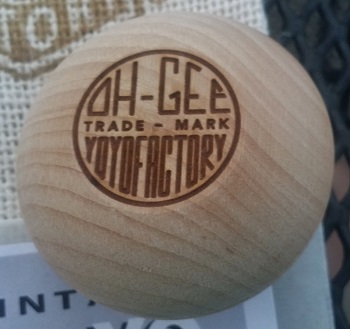|
 |
| YoYoFactory Oh-Gee |
| Exhibit #2590 |
 |
 |
| Type | Special Release |
| Shape | Standard (-) |
| Axle | Fixed |
| Finish | Unfinished |
| Construction | One piece wood |
| Response | None |
| Gap | Fixed |
| Condition | Mint |
| Date | 2016 |
| Owner | Rick Brough |
| Compare |  |
|
|
An unfinished, true one-piece wooden yo-yo made out of kiln dried Canadian maple baseball bat blanks and made entirely in the USA. The shape was made to resemble the original Flores model. Laser carving on the side says "Oh Gee - YoYoFactory" done in an old logo style similar to that of the original Flores. This version also had a stripe laser carved on the left and right sides of the logo, on one halve. The string gap is very narrow just like the original Flores yo-yo. YoYoFactory also included an old timey string pack with three specially narrow gauge cotton strings to use with the yo-yo.
The Oh-Gee was released June 6, 2016 for National Yo-Yo Day in the United States. Came in a burlap bag, string pack with 3 strings, and the yo-yo.
Original retail price: $15 US.
*****
The following is a fascinating look into the very early history of yo-yo. This information is from the YoYoFactory website, as researched and written originally by the good folks at YoYoFactory:
"The story begins more than 400 years ago when Spanish explorers first stepped foot off their Galleons onto the shores of the archipelago in the 16th century. Noted in a news article from 1916 the Filipino historians recollect that Spaniards first introduced the spin top to local tribes when trying to describe the shape of the earth and how it rotates in space.
In 1899 The Spanish conquerors were convinced to leave by U.S. forces who were gathering islands for strategic reasons throughout the Pacific, Gulf and Atlantic. Hawaii, Guam, Puerto Rico and Philippines were among these acquisitions.
In the set of books published in 1899 "Our Islands and Their People" we learn that as the American explorers travelled across the freshly acquired Islands they discovered that in Manila the "Tagalog" tribe had become very modern under the 300 years of Spanish occupation. The American explorers and industrialists worked with the Tagalog's to set up the "Philippine School of Arts and Trades" with the intent to help the Tagalog's share and trade their traditional hand carved crafts with the rest of the modern world through modern mass production techniques.
For example, yo-yos that were traditionally hand carved from the horn of the Caribou (Filipino Water Buffalo) one at a time could now be mass produced from one piece of wooden dowel on a lathe.
By 1916 the School of Arts and Trades were ready to share their mass produced goods with the USA. Among them were spin tops, dolls and yo-yos.
This El Paso Herald article above represents the earliest known use of the word "yo-yo" in print in the USA. Prior to this the toy had many names such as Bandalore, L'Emmigrate, Whirligig and creative names such as "Child's Spinning Top".
But the word "yo-yo" was forgotten for almost a decade in the USA until Pedro Flores, remembering the toy he played with as a child in the Philippines, replicated the production practices mastered by the School of Arts and Trades, and set up shop in Los Angeles in 1927. Although we can thank Pedro Flores for the concepts of mass distribution of the yo-yo, Professional travelling demonstration of the yo-yo, play pattern of holding trick contests and awarding prizes with yoyos -- ultimately we need to thank the Philippine School of Arts and Trades for bringing us the first mass produced, one piece, lathe cut yoyo with a string gap so narrow that they could only loop the thin string around the axle and twist rather than securing a knot. They brought to America the modern competition capable "sleeping" yoyo."
Original product description, also from the YoYoFactory website:
"Introducing the "Oh-Gee" from YoYoFactory®. Designed to allow the modern player to experience the feel and design of the first yo-yo in America.
This first design of the yo-yo was introduced in 1916 by the Manila based Philippine School of Arts and Trades during the Christmas holiday season in America. This event is the earliest documented use of the word Yo-Yo in the USA and is referenced in court documentation from a famous trademark battle from 1929-1932. In news stories from that time period, yo-yo maker Pedro Flores would reflect on the yo-yo he used as a boy growing up in the Philippines, which inspired his passion for teaching the game to the local neighborhood kids in San Francisco and eventually the start of mass producing yo-yos in Los Angeles, California.
The Oh-Gee is made in the exact shape and dimensions as the first mass produced, lathe cut, yoyos. Even the string has been custom formulated to match the narrow gap of this early yoyo design. The design is cut from 100% Canadian Maple kiln dried baseball bat blanks with a retro laser engraved graphic to ensure long lasting appearance and performance." |  |
| |
|
Other Examples
|
|
|
|
|
|  |
|
|
 |
|
|
 |
 |
|

